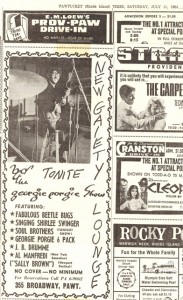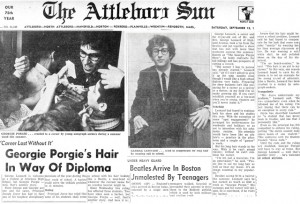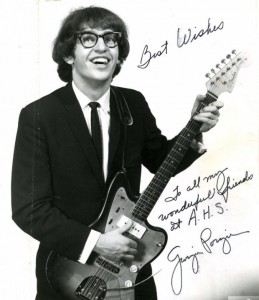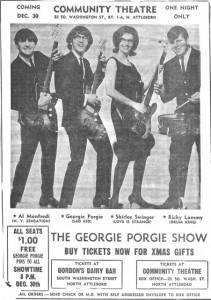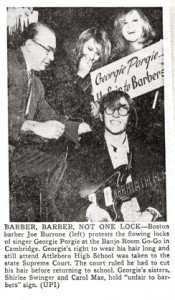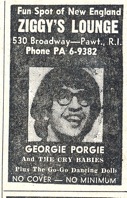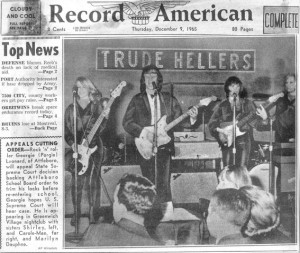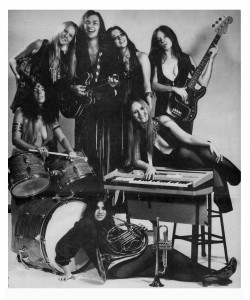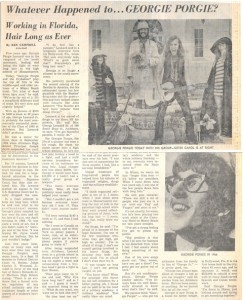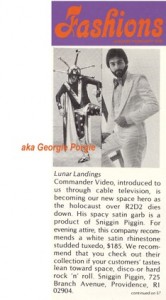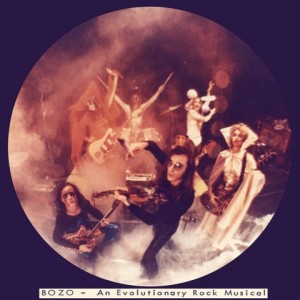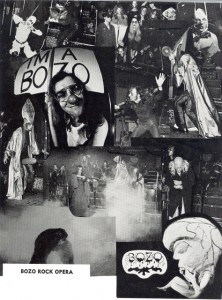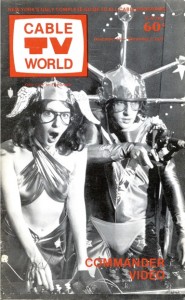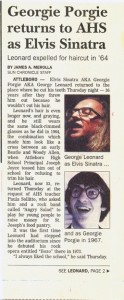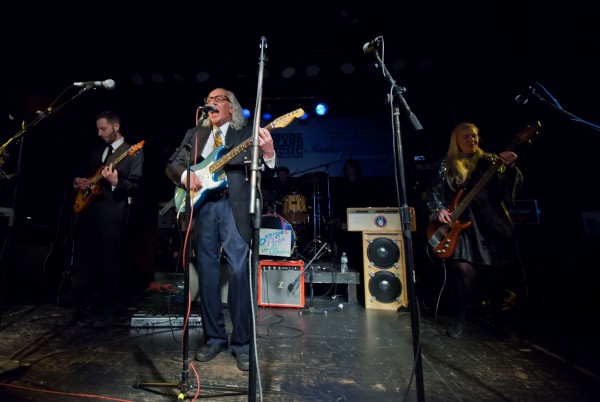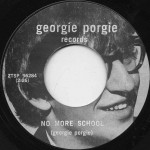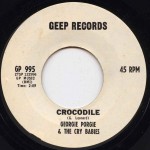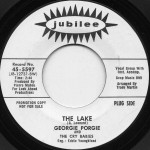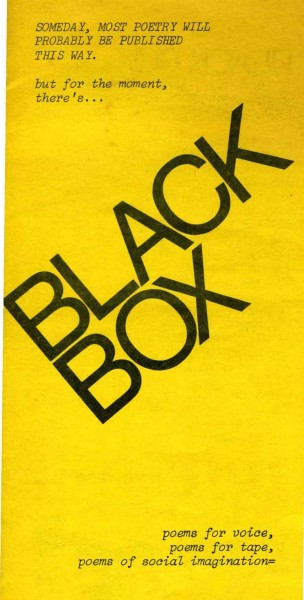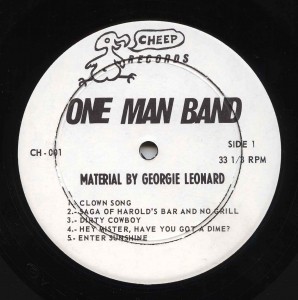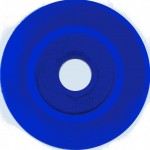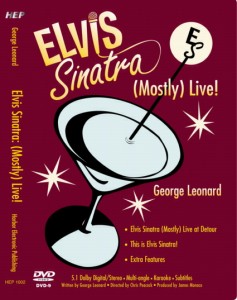Georgie Porgie/George Leonard
2015 INDUCTEE
Rock ‘n’ Roll
THE STORY OF GEORGIE PORGIE & THE CRY BABIES:
Rhode Island’s Original Rock ‘n’ Roll Rebels
by Rick Bellaire
with special thanks to George Leonard and Judy Leonard Hamin
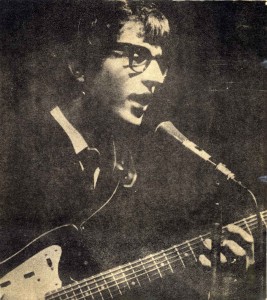 Had George Leonard, II of Pawtucket, Rhode Island, never picked up a guitar, formed a band, written a song or cut a record, his place in the pantheon of Rock ‘n’ Roll heroes would still be assured. It seems that while still a high school student, George, with the full support of his family, made a courageous stand for the Freedom Of Expression rights now taken for granted by students of all ages in The United States. Every kid who sports long hair, pink hair or a shaved head, or wears a nose ring, a tattoo or makeup, owes his right to do so to the musician who became known to the world-at-large as Georgie Porgie.
Had George Leonard, II of Pawtucket, Rhode Island, never picked up a guitar, formed a band, written a song or cut a record, his place in the pantheon of Rock ‘n’ Roll heroes would still be assured. It seems that while still a high school student, George, with the full support of his family, made a courageous stand for the Freedom Of Expression rights now taken for granted by students of all ages in The United States. Every kid who sports long hair, pink hair or a shaved head, or wears a nose ring, a tattoo or makeup, owes his right to do so to the musician who became known to the world-at-large as Georgie Porgie.
But we’re getting ahead of ourselves here. Let’s roll back to the beginning…
THE EARLY DAYS
George Leonard was born in Pawtucket in 1947. The family business was dry cleaning and business was good. George showed an early interest in – and aptitude for – all things musical and was encouraged by his parents to pursue those interests. By the time he was in grammar school, his mother was dutifully transporting him every Saturday morning to Petteruti’s Twin City Music on Main Street in Pawtucket for guitar lessons. He studied the instrument (as well as upright bass and music theory) with bassist Bob Petteruti, the second-generation proprietor of the store. George’s sisters, Carol and Judy, also studied a variety of instruments at Twin City including drums, bass and guitar. George progressed quickly and, at Petteruti’s urging, was enrolled in advanced studies at Boston’s Berklee School Of Music’s summer program for promising jazz students.
The beatnik era was still in full swing in the early 1960s and, in Providence, was centered around the East Side area in the midst of the Brown University/Rhode Island School Of Design community. The coffeehouse scene allowed access to the music and poetry of the beats to the underaged and George found himself sitting in regularly at jazz sessions at The Tete a Tete on Thayer Street. Due to his young age, he was dubbed “Georgie Porgie” by the club’s proprietress, “Ma” Tete, a name which has stuck with him throughout his career. His reputation was growing fast and George even made an appearance at the world-famous Newport Jazz Festival on upright bass with the Rhode Island Youth Jazz Band.
Although George’s prowess on guitar manifested itself mostly in the straight-ahead sounds of the modern jazz he loved, his ears were open to far more and he was equally attuned to the Rock ‘n’ Roll and Rhythm & Blues sounds flooding the airwaves in the late ’50s and early ’60s. By the time The Beatles arrived in America in 1964, George’s future was laid out before him. He adopted the Beatle haircut shortly after their groundbreaking appearances on The Ed Sullivan Show. He transformed the jazz group he’d formed with his sisters, The Georgie Porgie Trio, into a rock ‘n’ roll band which he dubbed Georgie Porgie & The Cry Babies. With George in front on guitar and lead vocals, the group was rounded out by his sisters Judy (who took the stage name “Shirlee Swinger”) on bass guitar and Carole-Mae on the drums.
Initially managed by their dad, George Leonard, Sr., the band made quick headway on the vibrant teen scene in southern New England performing at all the venues available to the underaged at that time: amusement parks, school dances, church halls and under-18 venues. Before long they were appearing in Cambridge, Massachusetts at The Banjo Room alongside other up-and-coming area bands such as The Remains (led by Barry Tashian), The Lost (featuring future punk-rocker Willie Alexander) and Cape Cod’s The Barbarians (soon to hit the big time with “Are You A Boy Or Are You A Girl?”). George also made another appearance on bass with the R.I. Youth Jazz Band, this time at the U.S. Pavilion at the New York World’s Fair in the summer of ’64.
THE LAWSUIT
During the intervening years, the Leonard family had moved across the state line into Massachusetts, first to South Attleboro and by 1964, to Attleboro where on September 11, 1964 – two days into his senior year of high school – George was sent home by the school’s prinicipal, Joseph E. Joyce, Jr., who told him that he would have to have his hair cut and that until he had done so he would not be allowed to return to school. George complied with the order by not returning to school!
On his behalf, his parents filed suit and argued several points:
– That although still a high school student, he had already established himself as a professional musician and that the length of his hair was an integral part of his image as a performer;
– That because he was still a minor, his appearance was under the exclusive control of his parents and the school department’s interference was an invasion of privacy;
– And that it was George’s constitutional right under U.S. guarantees of freedom of expression to decide how he would present himself to the world.
Recognizing a good “human interest” angle, The Attleboro Sun (the area’s newspaper of record) picked up the story and it soon hit the wire services. It became a national cause celebre and Georgie Porgie became a hero to millions of youngsters across the country.
Although the hearings would last an entire year, the Leonard family wasted no time in capitalizing on the notoriety of the band’s front man, and the Cry Babies’ career took off like a rocket. As George likes to answer whenever he’s asked if he’s ever had a hit record, “The lawsuit was my hit record.”
One of the first benefits of the publicity was an offer to open the show for The Rolling Stones at their first Rhode Island appearance. With a lineup now expanded to include Al “Albi” Manfredi on guitar and Dick Lamy on drums (Carole had moved over to keyboards), Georgie Porgie & The Cry Babies made their concert debut on November 3, 1964 at the Loew’s State Theatre in Providence. Unfortunately, the group was billed as “The Georgie Porgies”, but everyone in the area already knew who they were. George, of course, cashed in on the mistake! There was a general feeling in the group that “Cry Babies” was not an appropriate name for a backing band with two guys in the lineup, so they began billing themselves as The Georgie Porgies.
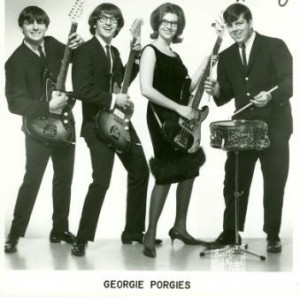
The band stuck with this name until Albi and Dick left the lineup and were replaced by female musicians at which point, they reverted to The Cry Babies for the remainder of their run
George’s far-sightedness also led him to realize that although an expanded gig schedule was a great step in the right direction, a recording to promote could really put them over the top. The band recorded tracks at one of the area’s first studios, LMN in North Attleboro, and released its first single, “Love You Girl Always” b/w “Could You Love Me” on its own Georgie Porgie record label bearing George’s visage complete with Beatle-length locks.
As the hearings dragged on, the Cry Babies soldiered on. During an appearance at Ziggy’s Lounge in Pawtucket, Leonard, Sr. was approached by a talent agent working out of New York City.
This led to the band’s first appearance in “The Big Apple” when he installed them at Jack Silverman’s International, a supper club which had been home to the world-famous Minsky’s Burlesque but was then trying to reach the younger set. The band performed to good notices and offers for further appearances at some of the city’s most prestigious discotheques began to pour in including Trude Heller’s and Arthur (where Jackie O. could often be spotted twisting the night away).
The lawsuit worked its way all the way to the Massachusetts Supreme Court and was finally over in December of 1965 with George winning on all points. It was a precedent-setting case and “GEORGE LEONARD, JR., & another vs. SCHOOL COMMITTEE OF ATTLEBORO & others” is cited to this day as a landmark decision in student rights and the freedom of expression rights guaranteed by the U.S. Constitution.
THE SWINGIN’ SIXTIES NEW YORK DISCOTHEQUE SCENE
Over the course of the next year, the band had changes in the lineup with Al Manfredi leaving to form his own group, Albi & The Spellbinders. Albi’s replacement was guitarist Marilyn Dauphne, who was on board for their first run at Trude Heller’s (at which time the group reverted to its original name, Georgie Porgie & The Cry Babies). She in turn was replaced by Danny Higgins who was soon to become Judy’s husband.
(The Spellbinders became one of most successful club bands in the history of southern New England. Although, sadly, Albi passed away in 2007, as of this writing, the group has continued performing with the remaining members carrying the torch which puts them near the top of the list of longest-running bands in New England.)
The Cry Babies put out three more singles on the Georgie Porgie label including a song about the lawsuit titled, appropriately, “No More School”. These were followed by another pair of releases on their new GP Records imprint: “Is This It” followed by “Meeting A Dream”.
The band continued performing throughout the northeast and it was during a run at Harlow’s in New York City that the band was approached by Pierre Maheu, an independent producer originally from New Bedford, Massachusetts. His most recent clients had been the post-“My Boyfriend’s Back” lineup of The Angels during their run at RCA Records. Maheu offered the band a singles deal.
THE JUBILEE RECORDS CONTRACT
Taking them into the studio, Maheu decided to go with studio musicians for the A-side. He chose “Holdin’ On” by songwriter Larry Weiss who had recently scored with “Bend Me, Shape Me” by The American Breed (and would go on to compose “Rhinestone Cowboy” for Glen Campbell). With the exception of George himself on lead guitar, the backing track for the A-side, “Holdin’ On”, was cut by the members of The Bold, a very tight unit who were then holding forth at The Playboy Club in Manhattan. (Rehearsals were held at the Cheetah on Broadway on the set of where the original cast of “Hair” was rehearsing!) On backing vocals were the Cry Babies themselves. It’s a great example of American psychedelia at its grungiest. The snare drum mic had presented some problems during recording, but it turned out great – its out-of-phase character created an out-of-this-world “pinging” slingshot effect which no one has ever been able to duplicate. There are some great fuzz leads by George toward the end of the side with his guitar run through a rotating Leslie organ speaker for a highly original sound.
For the B-side, the producer decided to simply tidy up one of the Cry Babies’ home studio recordings George had brought in as a demo. For this song, “He’s Just Like That”, a Georgie Porgie original, the group was augmented by drummer Bob Fish and a horn section consisting of three of Rhode Island’s future biggest jazz stars: a 14 year Hal Crook on trombone and the teenaged Giorgianni brothers, Joe on trumpet and Tony on saxophone. With very little remediation, the track was readied for release.
Maheu found a home for the master and in 1967, Jubilee Records #5578 became Georgie Porgie & The Cry Babies’ first national release. The record saw some action in the greater New York area and back home in southern New England, Vik Armen added it to the WPRO-AM playlist, but it failed to make the Hot 100.
The following year, Maheu took the band back in the studio for another go. This time the record featured two George Leonard originals, “The Lake” and “Enter Sunshine (Exit Darkness)”. “The Lake” is a great song and a dark slice of psych with the band backed by a gorgeous, full orchestra playing a spooky arrangement by the legendary Trade Martin. It is in the same vein The Beatles mined during the “Sgt. Pepper’s”/”Magical Mystery Tour” era. Studio legend Vinny Bell is on lead guitar and Coral Electric Sitar (his own invention) and the backing vocals are provided by none other than The Angels. The B-side was a co-write from an original melody by William Nosal, Maheu’s songwriting partner, which was given to George by Pierre to finish up and write the lyric. “Enter Sunshine” is the complete opposite of the A-side! It’s a poppy, soulful, happy song along the lines of what The Association were doing with Curt Boettcher on the west coast. The same fate befell this record as its predecessor and Peter Maheu left the world of independent production for a job as a staff producer at RCA.
(Today, both of these singles, as well as all of the band’s previous independent releases, are highly sought-after, pricey ’60s gems prized equally by collectors of garage, punk, psych and sunshine pop.)
FLORIDA AND THE MIAMI BEACH SCENE
By late 1968, George was tired of the highly competitive New York club scene and decided to move the band down to Miami, Florida where they could pursue a new direction for their music in a more relaxed setting. The senior Leonards assisted by installing the group in a run-down mansion under the condition that they all chip-in on restoring the place. During the warm days, the band alternately worked on the house and on their new sound. At night, they performed as the house band at the hippest club on the Miami scene, The Wreck, located at The Castaways Motel in Miami Beach. The Leonards and company were certainly in the middle of it during one of the most exciting periods in music history. One memorable evening occurred during the Miami Pop Festival. Jimi Hendrix, Frank Zappa and Jimmy Carl Black of The Mothers Of Invention, Arthur Brown of “Fire” fame, John Kay of Steppenwolf and the entire Vanilla Fudge band were all staying at The Castaways and they all sat in with the band during a single performance!
Around 1970, Judy and Danny decided to return to Rhode Island to pursue other interests. Back home, they founded Sniggin Piggin, a rock ‘n’ roll stage costume company. Headquartered in Rhode Island, Judy’s designs quickly became a nationwide success and she outfitted hundreds of club bands and show bands as well as recording and television stars including The Temptations, Doc Severinsen of Johnny Carson’s Tonight Show Orchestra, Mott The Hoople and Tavares. The company was in business for many years and today, her clothing lines are considered groundbreaking and historic with any examples turning up for auction going for big bucks among retro and kitsch collectors.
Back in Florida, the band continued performing and working on new music while George looked for alternative places to play instead of the strip. While on his quest, George began collaborating with local poet Edmund Skellings, an English professor at Florida-Atlantic University who was a former RCA Victor recording artist with two LPs of original poetry to his credit. In small bars and coffeehouses, Skellings would read and George would back him on his electric guitar run through an early electronic music device called the Maestro G1 Rhythm ‘N’ Sound and an Echoplex tape delay unit. This allowed George to create the sound of an entire band and manipulate the guitar to produce illustrative audio effects to compliment the images in the poetry. With copious amounts of Mogen David wine and frequent encouragement from Skellings’ drinking buddy, Norman Mailer, the two artists composed and recorded a long-form piece on George’s twin Ampex tape decks which allowed them to create layers of overdubs. The result was the fifteen minute “Concerto For Voice and Guitar” featuring sixteen tracks of vocals, guitars, sound effects and “found” ambient noise (including Skellings engaged in a sex act with one of his girlfriends!) which was distributed nationally by Black Box, the audio magazine of the National Endowment For The Arts. (Skellings later became Poet Laureate For Life of the State of Florida.)
By 1970, George had assembled a song cycle of mostly new material which he’d decided to record as true solo album: he’d play all the instruments himself. He began making the rounds and he was befriended by Atlantic Records producer Tom Dowd and his engineers, the Albert brothers (Ron and Howie) over at Criteria Studios in Miami. They were in the midst of recording one of the greatest albums of the 20th century, “Layla and Other Love Songs” by Eric Clapton’s Derek & The Dominos featuring future guitar legend Duane Allman. They still found time, however, to assist George with his new project by allowing him to record during lunch hour at the studio on the condition he didn’t change the EQ settings on the board too much. George was careful to achieve his sounds pre-recording and did not impair the progress of “Layla” in any way!
The resultant LP, released in a limited, independent pressing with a plain white cover, listed the artist as “One Man Band” and the composer as George Leonard. It is a masterpiece of the era and the method. The album (which George refers to as “Suicide” for no particular reason except that it was a depressing time for him), stands the test of time and stands up to others of its ilk from that time such as Paul McCartney’s “McCartney”, the first two post-Nazz Todd Rundgren LPs under his alter-ego “Runt” and ex-Merry Go Round leader Emitt Rhodes’ first two solo albums. But by the time the album was released, George had already moved on. He began rehearsing new material with a new group of musicians including a young Jaco Pastorius, then a bass student at the University of Miami. The ensemble’s work is documented on a single recording, “Ernie The Narc”. The group, however, quickly ran its course with Jaco taking off to join Wayne Cochran & The CC Riders and, soon after, taking the world by storm with his musical prowess and bass guitar innovations.
(The original pressing of the LP is today considered an extremely rare collectors piece and in the 1980s, the owner of underground record label American Sound tracked down George to negotiate a reissue. The second LP pressing, this time with cover art and a bonus 7″ of the Jaco track and another outtake, is now itself considered a collectors item.)
THE BOZO ROCK OPERA
After Jaco left the fold, George finished composing the bulk of his next major work: a rock opera. “Bozo – An Evolutionary Rock Musical” was both a reflection on and an indictment of the times commenting on everything from the war in Vietnam to birth control. To mount the opera, George returned to Rhode Island and formed the nucleus of the company which would perform the piece for the next few years. He re-enlisted his sisters Judy on bass and Carole on keyboards and recruited two new drummers, cousin Ted Leonard and Jimmy Wittle, as well as a second bass player, Tom Estrella. This allowed for the musicians to double as actors in the story without losing an instrumental voice in the musical score. Rounding out the “pit band” were Wittle’s sister Joyce and his girlfriend, Donna Vachon, on backing vocals. The costumes were produced at Sniggin Piggin with George himself constructing the giant fiberglas foetus head used in one scene.
They performed the opera at colleges and clubs all over New England and there was a showcase in New York at The Hippodrome arranged by Leber & Krebs, then managers of Aerosmith, to which the record labels were invited. But by 1975, the opera had run its course without securing a record deal for the group and George downsized to a trio. He continued performing his original music on the southern New England club scene as The Bozo Band with Estrella and his cousin Teddy.
CABLE TELEVISION PIONEER
George returned to New York in 1977 to take advantage of the new public access laws which accompanied the cable television explosion. He began to write for and act in his own series, “Commander Video: Spaceman Cable TV” for which he also composed all of the original music.
Today, “Commander Video” is considered a groundbreaking, pioneering series of the medium and the stories are legend. But despite the growing viewer base and critical acclaim, cable access shows rarely pay the bills and when he found out that he was to become a father, George hung up his rock ‘n’ roll shoes and returned to Rhode Island to work in the family cleaning business and raise his new son.
ELVIS SINATRA AND THE JAZZ YEARS
A decade later, George began to stick his toes back into the waters of the music business. This time, he returned to his roots by taking a jazz-based approach. He began performing with pianist Shorty James at Bumblebee’s, a jazz club on the East Side of Providence (located at the final home of the legendary Lloyd’s Deli). George presented rock ‘n’ roll covers and new satirical compositions in the style of a ’50s crooner. The notices were good and George soon fully developed the character into his latest alter-ego, “Elvis Sinatra.” Before long, he found himself back in Manhattan with a steady gig in the East Village at the jazz club Detour. For the next five years, he performed as Elvis to great reviews and a growing audience. There was an album release which brought things full circle. Recorded in Providence, it finds George in fine form with backing provided by his original musical mentor, bassist Bob Petteruti and an all-star Rhode Island lineup. One of its tracks, “Handsome Guys,” was featured in the hit movie “Shallow Hal” which starred Gwyneth Paltrow and Jack Black. The album was followed the next year by a DVD of a live performance, but by 2000, after moving the act over to another Manhattan nightspot, The Fez, George retired the act.
George is still active in the music business and performs regularly as “Sir” George Leonard with acclaimed jazz composer/musician/vocalist Phoebe Legere & The Ooh La La Coqtail Quintet.
On April 26, 2015, Georgie Porgie & The Cry Babies were inducted into the Rhode Island Music Hall of Fame. George, Judy and Carole were all on hand to accept their awards and the band, augmented by George’s son Geo Leonard, performed for the first time in nearly fifty years.
All images appear courtesy of Judy Leonard Hamin and the Leonard Family Archive with the exception of the “Georgie Porgies” promotional photo
This historic photo appears here courtesy of longtime Spellbinders member Bruce “Rooster” Perry. Readers are encouraged to visit the band’s website to learn more about one of the finest and longest-running acts in Rhode Island music history: http://www.thespellbinders.com
GEORGE LEONARD DISCOGRAPHY
By Rick Bellaire
with special thanks to George Leonard
GEORGIE PORGIE & THE CRY BABIES
Georgie Porgie Records
96279/80 Love You Girl Always b/w Could You Love Me 1964
96281/82 Hurt b/w Sad Kid 1964
96283/84 You Don’t Know Me b/w No More School 1964
96285/86 Little Man b/w Hey Watcha My Lips Kiss You 1965
96401/02 Love You Girl “Always” b/w Could You Love Me 1965
Reissue of first single
GP Records
694 Is This It b/w You’ve Been Gone A Long, Long Time 1966
995 Meeting A Dream b/w Crocodile 1966
Jubilee Records
5578 Holdin On b/w He’s Just Like That 1967
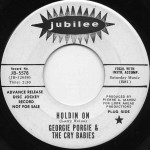 5597 The Lake b/w Enter Sunshine (Exit Darkness) 1968
5597 The Lake b/w Enter Sunshine (Exit Darkness) 1968
EDMUND SKELLINGS & GEORGE LEONARD
National Endowment For The Arts: Black Box (Audio Cassette Magazine)
NEA-CS Concerto For Voice And Guitar 1970
ONE MAN BAND
Cheep Records
LP CH-001 Material By George Leonard 1971
The Clown
Harold’s Bar And No Grille
Dirty Cowboy
Hey Mister, Have You Got A Dime
Enter Sunshine
Early Mornin’ Woman
Bar Room Hippie
Just Another Link
The Lake
GEORGIE LEONARD
American Sound Records
LP AS-1006 One Man Band 1981
Two limited edition reissues of 500 numbered copies each with a bonus blue vinyl 7″ single
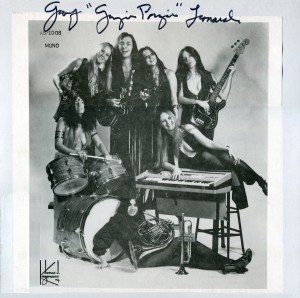
First American Sound limited edition reissue pressing of 500 numbered copies with pasted on front cover
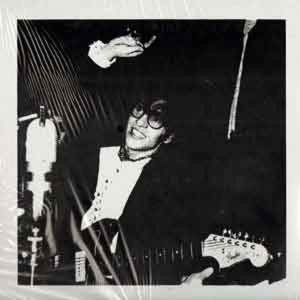
Second American Sound limited edition reissue pressing of 500 numbered copies with printed front cover
AS-45 106460/61 Bonus single for the American Sound reissues
Ernie The Nark (with Jaco Pastorius) b/w Bar Room Hippies (Cry Babies outtake)
ELVIS SINATRA
Harbor Electronic Publishing
CD HEP-1001 East Village Vegas! 1999
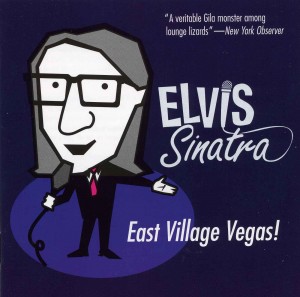 Criminal
Criminal
I Love Myself When I’m With You
Pisces
Handsome Guys
Little Miss Fortune
Naughty Angels
Double L
Superhero
Charlene
Whoever Said You Were Gone
DVD HEP-1002 (Mostly) Live! 2000
GEORGE LEONARD LINKS
For more information on this great Rhode Island artist, please visit his official website at:
For more information on the lawsuit, please visit the Massachusetts state legal archive to read about the final decision:
